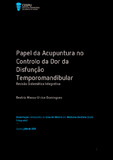Papel da Acupuntura no Controlo da Dor da Disfunção Temporomandibular
Abstract
Introdução: Quando existe uma anomalia/disfunção na ATM, designamos como Disfunção Temporomandibular (DTM). Esta anomalia provoca sintomatologia dolorosa e nesse sentido surge a necessidade de novos métodos no alívio da dor. A acupuntura surge como alternativa a fármacos sedativos usados habitualmente, para o controle da dor associada à DTM.
Objetivo: Determinar se efetivamente a acupuntura desempenha uma função proveitosa no controlo da dor da DTM, tendo como principal intuito reunir conhecimentos de forma a fundamentar a prática de Medicina Tradicional Chinesa (MTC) na vertente da prática clínica da Medicina Dentária.
Materiais e Métodos: Foi realizada uma pesquisa eletrónica em duas bases de dados, nomeadamente PubMed e ScienceDirect, utilizando como palavras-chaves: “Acupuncture treatment“, “Pain Control” , “Disorders Temporomandibular”. Foi definido um período de 10 anos para a inclusão dos estudos.
Resultados: Foram identificados 499 artigos, 9 dos quais incluídos nesta revisão sistemática integrativa (RSI).
Conclusões: Podemos concluir que a acupuntura tem-se revelado cada vez mais eficaz no alívio da dor da DTM, ajudando, nomeadamente na sintomatologia dolorosa. No entanto, por ser uma abordagem recente devem continuar a ser realizados estudos com o intuito de encontrar novos benefícios desta técnica da MTC para o uso na prática clínica de medicina dentária. Introduction: When there is an anomaly/dysfunction in the TMJ, we call it Temporomandibular Disorder (TMD). This anomaly causes painful symptoms and, in this sense, there is a need for new methods of pain relief. Acupuncture appears as an alternative to commonly used sedative drugs in the management of the pain associated to TMD.
Objective: To determine whether acupuncture effectively plays a useful role in controlling TMD pain, with the main aim of gathering knowledge to support the practice of Traditional Chinese Medicine (TCM) in terms of the clinical practice of Dentistry.
Materials and Methods: An electronic search was carried out in two databases, namely PubMed and ScienceDirect, using the following keywords: “Acupuncture treatment”, “Pain Control”, “Temporomandibular Disorders”. A period of 10 years was defined for the inclusion of studies.
Results: 499 articles were identified, 9 of which were included in this integrative systematic review (IRS).
Conclusions: We can conclude that acupuncture has proved to be increasingly effective in relieving TMD pain, helping with painful symptoms. . However, as it is a recent approach, studies should continue to be carried out to find new benefits of this TCM technique for use in clinical practice in dentistry.

